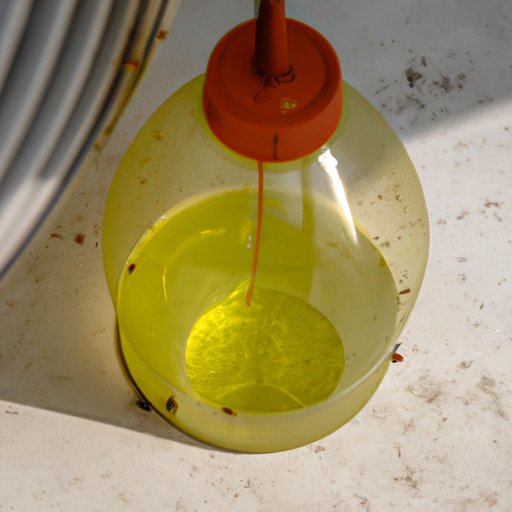I. Introduction
Yellow jackets are a common insect that many of us encounter in our daily lives. These aggressive wasps can cause discomfort, pain and sometimes even health problems for people and pets. In this article, we will explore some of the most effective methods of getting rid of yellow jackets. Whether you prefer DIY solutions or want to call in a professional exterminator, there are many ways to deal with these pesky insects.
II. DIY Trap
A DIY trap is a simple and affordable way to get rid of yellow jackets. To make one, start by cutting off the top third of a plastic bottle and inverting it into the bottom of the bottle. Then, add some sugary bait like fruit juice, soda or honey to the bottom of the trap. Finally, place the trap near the area where yellow jackets are buzzing around and wait for them to crawl in and get stuck.
Materials you’ll need to make a DIY trap include a plastic bottle, scissors or knife, and bait such as sugar, honey or fruit juice. Remember to dispose of the traps properly to prevent attracting more yellow jackets.
III. Professional Exterminator
If your yellow jacket problem is severe or if you’re dealing with a nest that poses a risk, consider calling a professional exterminator. The cost of extermination can vary depending on the size of your property and the severity of the infestation.
Before calling, make sure you are aware of any precautions you need to take, such as clearing the area around the nest or vacating the premises during the extermination process. After the extermination, you may need to clean and repair any damage caused by the yellow jackets.
IV. Insecticide Sprays or Dust
Insecticide sprays or dust can be effective when used correctly. When selecting an insecticide, look for one that is labeled for yellow jackets and follow the instructions carefully. Most insecticides require multiple applications to be effective.
When using insecticides or dust, it’s important to wear protective clothing such as long-sleeved shirts, pants, gloves and goggles. Keep children and pets away from the area during and after treatment.
V. Cover Food and Drinks
Yellow jackets are attracted to sugary foods and drinks, so when outdoors, it’s important to cover your food and drink containers. There are many types of covers available, including netted tents, covers with zippers, and individual covers for cups and plates.
Make sure to keep track of any spills or crumbs as well, as they can attract yellow jackets to your picnic area.
VI. Remove Potential Nesting Sites
Yellow jackets are known to build nests in a variety of places, including in the ground, in trees, and in wall voids. Some of the most common nesting sites include eaves, porches, and attics.
To remove potential nesting sites, start by inspecting your property for any signs of yellow jacket activity. If you locate a nest, use caution and avoid disturbing it. If you’re unsure of the best way to remove or modify the site, consider calling a professional exterminator.
VII. Use Essential Oils
Essential oils can be a natural way to repel yellow jackets. Some of the most effective oils include peppermint, lemongrass, and clove. To use essential oils, mix a few drops with a carrier oil such as coconut oil and apply it to your skin or clothing.
Essential oils can also be used in a diffuser to help repel yellow jackets from indoor areas. Always follow the instructions on the essential oil bottle, and be sure to store the oils out of reach of children and pets.
VIII. Plant Herbs and Flowers
Planting herbs and flowers around your property can help repel yellow jackets. Some of the most effective plants include mint, basil, and marigold. These plants not only repel yellow jackets but also add beauty to your landscaping.
When planting, consider the location of your property and the amount of sunlight and water the plants will require. With proper care, these plants can bring a variety of benefits beyond repelling yellow jackets.
IX. Conclusion
As you can see, there are many ways to get rid of yellow jackets. Whether you prefer a DIY solution or want to call in a professional, there are options to fit your needs. Remember to take precautions to protect yourself and others, and always follow the instructions carefully. By taking preventative steps and maintaining your property, you can enjoy a yellow jacket-free environment.
Call to action: Have you tried any of these methods? Share your experiences and tips with us in the comments below.
